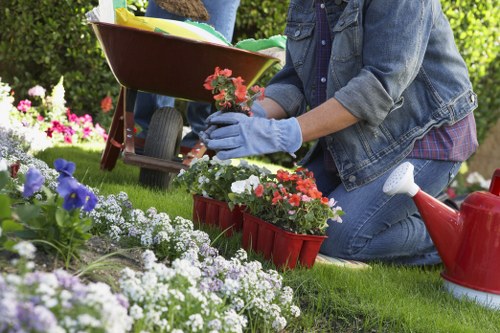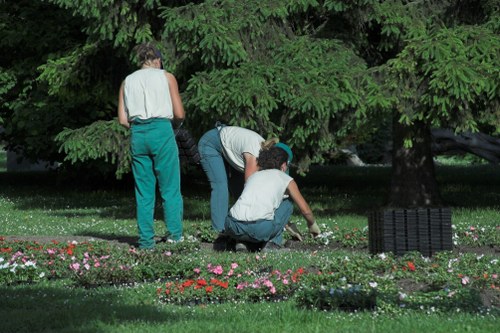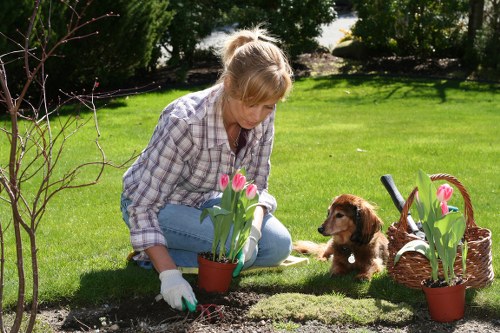Lawn Mowing in Lawn Turf Installation
Introduction

Creating a beautiful and healthy lawn involves more than just planting grass. Proper lawn mowing plays a crucial role in maintaining the aesthetic appeal and overall health of your turf. Whether you're installing new lawn turf or caring for an existing one, understanding the nuances of lawn mowing can make a significant difference.
In this comprehensive guide, we'll explore the essential aspects of lawn mowing in lawn turf installation. From the importance of mowing to best practices and common mistakes to avoid, you'll gain valuable insights to ensure your lawn remains lush and vibrant.
By the end of this article, you'll be equipped with the knowledge to effectively manage your lawn mowing routine, contributing to a picturesque and thriving outdoor space.
Importance of Proper Lawn Mowing

Proper lawn mowing is integral to maintaining a healthy lawn. It not only enhances the visual appeal of your outdoor space but also contributes to the overall health and resilience of your grass. Here's why regular and correct mowing is essential:
Promotes Healthy Grass Growth
Regular mowing encourages grass to grow thicker and healthier. By cutting the grass at the right height, you stimulate the plant to produce more blades, leading to a denser and more resilient lawn.
Enhances Curb Appeal
A well-mowed lawn significantly boosts the curb appeal of your home. It creates a neat and orderly appearance, making your property more inviting and attractive to visitors.
Prevents Weed Infestation

Frequent mowing helps prevent weed infestation by removing weed seeds and reducing their ability to spread. A dense, well-maintained lawn crowds out weeds, minimizing their presence without the need for chemical treatments.
Additionally, regular mowing ensures that your lawn remains uniform and free from unruly growth, which can attract pests and diseases.
Mowing also helps in controlling the spread of invasive grass species, maintaining the integrity of your lawn turf.
Lawn Turf Installation Overview

Lawn turf installation involves several steps to establish a healthy and beautiful lawn. Understanding each phase ensures successful turf establishment and long-term lawn health.
Choosing the Right Turf
Selecting the appropriate turf type for your region and soil conditions is crucial. Consider factors such as climate, foot traffic, and maintenance requirements when choosing your grass variety.
Preparing the Soil
Proper soil preparation is vital for turf installation. This includes removing existing vegetation, tilling the soil, and incorporating necessary nutrients to provide a fertile foundation for new grass.
- Remove old grass and weeds
- Loosen the soil to a depth of 6-8 inches
- Add compost or fertilizer as needed
Laying the Turf

Once the soil is prepared, the turf can be laid. Ensure the grass rolls are placed tightly together, staggering the seams like bricks to prevent gaps. Water the newly laid turf thoroughly to help it establish roots.
Proper installation techniques set the stage for a resilient lawn capable of withstanding various environmental stressors. Following best practices during installation minimizes the need for intensive maintenance later on.
After laying the turf, it's essential to monitor its growth and health closely, making adjustments to your mowing routine as the grass becomes established.
Integrating Lawn Mowing with Turf Installation

Effective lawn mowing is particularly important during and after turf installation. Proper mowing practices contribute to the successful establishment of new grass and long-term lawn health.
Timing Your First Mow
It's advisable to wait until the new turf has rooted firmly before mowing. Typically, the first mow should occur when the grass reaches about 3 inches in height, allowing it to develop a robust root system.
Delaying the initial mowing prevents stress on the young grass and ensures it establishes well in its new environment.
Mowing Techniques for New Turf

When mowing newly installed turf, use sharp mower blades to make clean cuts, reducing the risk of tearing the grass. Adjust the mower height to remove only the top third of the grass blades, promoting healthy growth without causing undue stress.
Avoid mowing too frequently, as the new grass needs time to build strength and establish its roots.
Implementing these mowing techniques helps in nurturing the newly planted turf, ensuring a healthy and vibrant lawn.
Best Practices for Lawn Mowing Post-Installation

Once your lawn turf is established, maintaining it through regular mowing becomes part of your routine. Adhering to best practices ensures your lawn remains healthy and aesthetically pleasing.
Mowing Height and Frequency
Adjusting the mowing height based on grass type and seasonal growth patterns is essential. Generally, taller grass provides better shade for the soil, reducing weed growth and conserving moisture.
- Fertilize regularly to support growth
- Mow in the morning to reduce stress
- Change mowing patterns to prevent soil compaction
Equipment Maintenance

Maintaining your mowing equipment ensures efficient and effective lawn care. Regularly sharpen mower blades to facilitate clean cuts and prevent grass damage. Clean the mower deck to avoid buildup of grass clippings and debris, which can affect performance.
Regular maintenance extends the lifespan of your equipment and ensures consistent mowing results.
Consider servicing your mower seasonally to address any wear and tear, keeping it in optimal condition for your lawn care needs.
Seasonal Mowing Adjustments

Adjusting your mowing routine based on seasonal changes is crucial for maintaining a healthy lawn throughout the year. Different seasons bring varying growth rates and environmental conditions that affect your grass.
Spring
In spring, grass growth accelerates, requiring more frequent mowing. Ensure your lawn is adequately hydrated and fertilized to support vigorous growth.
- Increase mowing frequency as needed
- Apply a balanced fertilizer to promote growth
Summer

During summer, high temperatures and potential drought conditions necessitate careful mowing. Raise the mower height to provide shade to the soil, reducing moisture loss and heat stress on the grass.
Avoid mowing during the hottest part of the day to minimize grass stress.
Implementing these adjustments helps your lawn withstand summer challenges and maintain its health.
Common Mistakes to Avoid

Even with the best intentions, certain mowing practices can harm your lawn. Being aware of common mistakes helps you avoid pitfalls and maintain a healthy turf.
Cutting Too Short
One of the most prevalent mistakes is cutting the grass too short, known as 'scalping.' This practice weakens the grass, making it more susceptible to weeds, pests, and diseases.
- Maintain recommended mowing heights
- Avoid removing more than one-third of the grass blade at a time
Neglecting Mower Maintenance

Failing to maintain your mower can lead to poor cutting performance and damage to your lawn. Regularly sharpen blades, clean the mower deck, and perform routine maintenance to ensure optimal operation.
Ignoring mower upkeep not only affects the quality of your mow but can also shorten the lifespan of your equipment.
Benefits of Professional Lawn Mowing Services

While DIY mowing can be effective, hiring professional lawn mowing services offers numerous advantages. Professionals bring expertise and equipment that can elevate the quality of your lawn care.
Expertise and Knowledge
Professional lawn care providers understand the intricacies of grass types, soil conditions, and optimal mowing practices. Their expertise ensures your lawn receives the best possible care tailored to its specific needs.
- Customized mowing schedules
- Expert advice on lawn health
Quality Equipment

Professionals utilize high-quality equipment that delivers precise and efficient mowing results. This ensures a uniform cut and minimizes damage to your grass.
Advanced tools and machinery allow for a more thorough and consistent mow, enhancing the overall appearance of your lawn.
Conclusion

Effective lawn mowing is a cornerstone of successful lawn turf installation and maintenance. By understanding and implementing proper mowing techniques, you can foster a healthy, lush, and visually appealing lawn.
Whether you choose to mow your lawn yourself or hire professionals, adhering to best practices ensures the longevity and beauty of your turf.
Investing time and effort into proper lawn mowing pays off with a vibrant and resilient lawn that enhances your outdoor living space.
Call to Action
Contact us today to ensure your lawn remains lush and healthy with our professional mowing and turf installation services!